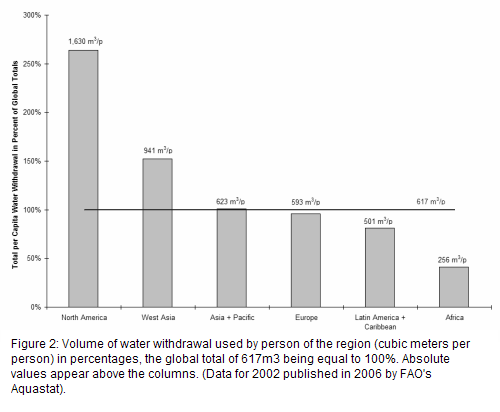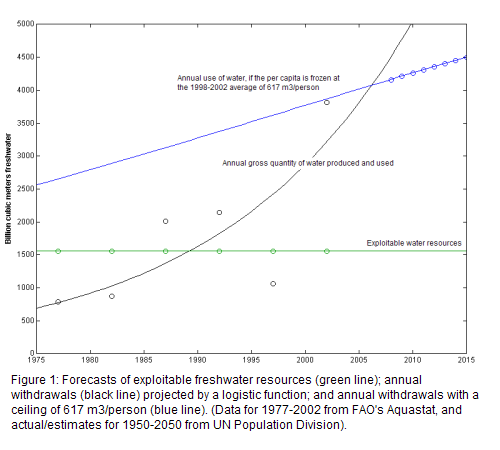
|
Insight : water |

|
|
You are here: areppim > Nature > Water
Water: huge deficit in the making
"Is there enough land, water, and human capacity to produce food for a growing population over the next 50 years?" - ask concerned scientists of IWMI (International Water Management Institute).
Maybe so, but if the current food production and environmental trends are not altered, many parts of the world will face a crisis. Water is the crux. Three quarters of the planet's population, according to estimates by the United Nations, may experience water shortage by 2050.


Reserves are scarce
Available data deliver quite a sobering message. Today's water consumption trends must be checked, lest we should take the world to the brink of chaos.
- Known reserves of exploitable freshwater are estimated at 1,560 billion cubic meters (see Fig. 1). In fact, they might even shrink, as an effect of the earth's climate change. Approximately by 1990, freshwater use reached that level.
- Since 1990, use of water continued its unrestrained ascension, far exceeding the reserves. By 2006, total global freshwater withdrawals were estimated at 3,800 billion cubic meters, 2,700 billion cubic meters (or 70%) being used by agriculture, 20% by industry, and 10% by municipalities.
- Our areppim's forecast based on FAO's (Food and Agriculture Organisation) actual data for the period 1977 – 2002, shows that water usage may go through the roof after 2010, dramatically deepening the global freshwater deficit.
- Even if we succeed to freeze water consumption at the 2002 level of 617 cubic meters per person, the deficit will grow deeper, although at a slower rate, by the sheer effect of population growth.
The bottom line is that lukewarm actions won't do. Radical steps must be taken to simultaneously save, better manage, recycle, and wherever possible increase reserves of water.
The deficit makers
The principal culprits of the current deficit are agriculture and production of food. To produce enough food to satisfy a person’s daily dietary needs takes about 3,000 litres of water, about 1 litre per calorie. As a yardstick, only about 2 litres of water are required for drinking. This sector underwent significant changes in the last fifty years:
- Twice as many people today,
- Populations are significantly wealthier,
- They eat many more calories,
- Meat ceased to be a rare luxury,
- Modern agriculture uses unsparingly fertilizers and pesticides that contaminate underground waters.
Industry is also responsible:
- The craving for energy puts a burden on water usage (as vapour to drive power generating turbines, also as a coolant in power plants), and water sharing (dams retaining water that does not reach the river basin),
- Production of fibbers for clothing and lately the production of biomass for fuel substitutes place heavy stress on water.
- Releases of industrial pollutants are a constant source of contamination.
Lastly, the growing numbers of middle-class people worldwide, the strong urbanisation and other social and civilisation changes compound the water balance-sheet problem:
- Green lawns and glittering swimming pools pepper today's urban landscape,
- Modern homes lavishly consume water in bathrooms, toilets, washing machines, decorative ponds, and the like,
- Faulty municipal waste disposal systems are another important source of water contamination.
The impact of affluent people's lifestyles on global water consumption is obvious (see Fig.2). The volume of water withdrawal used by person of North America is 2.7 times as high as the world average, and 6.4 times as high as Africa's.
The threat
Today, more than 1.2 billion, a fifth of the world’s people, live in areas where water available cannot actually meet everyone’s demands. About 1.6 billion people live in water-scarce basins, where human capacity or financial resources are likely to be insufficient to develop adequate water resources.
The combined consequences of growing demand, driven by more affluence, growing population and lifestyle habits, on one hand, and of diminishing reserves, driven by climate changes, aridity, coastal influxes of saltwater and ineffective water management (e.g. leaky water-delivery systems, open-air irrigation canals allowing high evaporation, depletion of used waters also known as "grey water"), on the other hand, may prove unaffordable.
The reader's imagination can easily fill the canvas with the pictures of starvation, disease, social unrest, political instability, warfare that such a situation may generate.
What can one do? For starters, a few inspiring pointers are provided by Waterfootprint.org: Water footprint and virtual water.
- FAO AQUASTAT, Information System on Water in Agriculture.
- IWMI - International Water Management Institute, Comprehensive Assessment of Water Management in Agriculture.
- United Nations Population Division's annual estimates and projections.]
Download


 Go toTop
Go toTop
 Home
Home